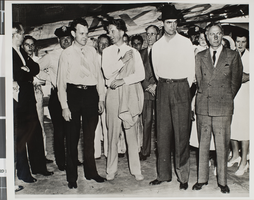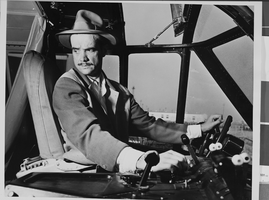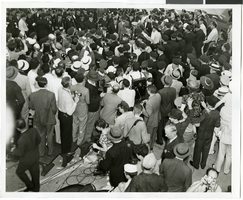Search the Special Collections and Archives Portal
Search Results
New York-New York, Monte Carlo, The Stratosphere, and MGM: postcard, approximately 1992 to 2000
Level of Description
Item
Archival Collection
Dennis McBride Photograph Collection
To request this item in person:
Collection Number: PH-00263
Collection Name: Dennis McBride Photograph Collection
Box/Folder: Folder 010
Collection Name: Dennis McBride Photograph Collection
Box/Folder: Folder 010
Archival Component

Photograph of Howard Hughes and other men, circa late 1930s
Date
1937 to 1939
Archival Collection
Description
Howard Hughes and other unidentified men surrounded by crowds.
Image

Photograph of Howard Hughes' Flying Boat, Long Beach, California, November 02, 1947
Date
1947-11-02
Archival Collection
Description
A view of Howard Hughes inside and at the controls of the Spruce Goose in Long Beach, California.
Image

Photograph of crowds at Floyd Bennett Airfield, New York, July 14, 1938
Date
1938-07-14
Archival Collection
Description
The black and white view of a crowd of people watching the arrival of Howard Hughes and his crew in Hughes' Lockheed 14 aircraft after completing the Around the World flight at Floyd Bennett Airfield, New York. Description printed on photograph's accompanying sheet of paper: "Howard Hughes lands at Floyd Bennett Field. 7/38"
Image
New York, New York Hotel and Casino, image 002: postcard, 1997 January 03
Level of Description
Item
Archival Collection
Dennis McBride Photograph Collection
To request this item in person:
Collection Number: PH-00263
Collection Name: Dennis McBride Photograph Collection
Box/Folder: Folder 005
Collection Name: Dennis McBride Photograph Collection
Box/Folder: Folder 005
Archival Component
New York New York Hotel & Casino: site plan, 1995 May 11
Level of Description
Item
Archival Collection
UNLV University Libraries Collection of Architecture Drawings
To request this item in person:
Collection Number: MS-00923
Collection Name: UNLV University Libraries Collection of Architecture Drawings
Box/Folder: Flat File 126
Collection Name: UNLV University Libraries Collection of Architecture Drawings
Box/Folder: Flat File 126
Archival Component
#67121: Valdex, Jesus (Student) Interns at New York-New York, 2009 July 09
Level of Description
File
Archival Collection
University of Nevada, Las Vegas Creative Services Records (2000s)
To request this item in person:
Collection Number: PH-00388-04
Collection Name: University of Nevada, Las Vegas Creative Services Records (2000s)
Box/Folder: N/A
Collection Name: University of Nevada, Las Vegas Creative Services Records (2000s)
Box/Folder: N/A
Archival Component
New York New York roller coaster, Las Vegas, Nevada, 2016 November 08
Level of Description
File
Archival Collection
UNLV University Libraries Photographs of the Development of the Las Vegas Valley, Nevada
To request this item in person:
Collection Number: PH-00394
Collection Name: UNLV University Libraries Photographs of the Development of the Las Vegas Valley, Nevada
Box/Folder: N/A
Collection Name: UNLV University Libraries Photographs of the Development of the Las Vegas Valley, Nevada
Box/Folder: N/A
Archival Component
New York New York entrance to ""The Park,"" Las Vegas, Nevada, 2016 November 08
Level of Description
File
Archival Collection
UNLV University Libraries Photographs of the Development of the Las Vegas Valley, Nevada
To request this item in person:
Collection Number: PH-00394
Collection Name: UNLV University Libraries Photographs of the Development of the Las Vegas Valley, Nevada
Box/Folder: N/A
Collection Name: UNLV University Libraries Photographs of the Development of the Las Vegas Valley, Nevada
Box/Folder: N/A
Archival Component
New York New York entrance to ""The Park,"" Las Vegas, Nevada, 2016 November 08
Level of Description
File
Archival Collection
UNLV University Libraries Photographs of the Development of the Las Vegas Valley, Nevada
To request this item in person:
Collection Number: PH-00394
Collection Name: UNLV University Libraries Photographs of the Development of the Las Vegas Valley, Nevada
Box/Folder: N/A
Collection Name: UNLV University Libraries Photographs of the Development of the Las Vegas Valley, Nevada
Box/Folder: N/A
Archival Component
Pagination
Refine my results
Content Type
Creator or Contributor
Subject
Archival Collection
Digital Project
Resource Type
Year
Material Type
Place
Language
Records Classification
